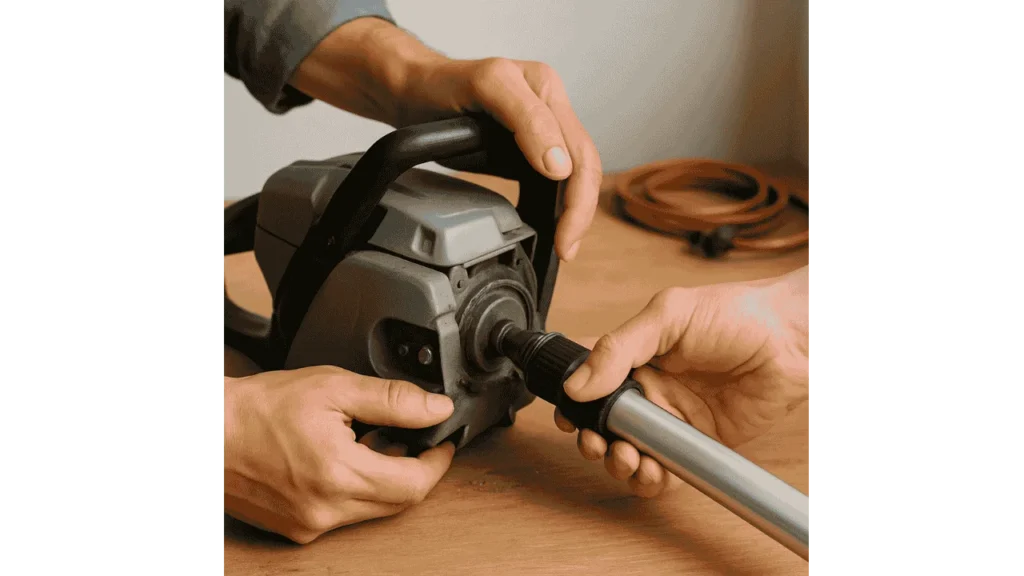At first glance, screwing a lightweight paint‑pole extender onto a chainsaw head might feel like the ultimate do‑it‑yourself solution: instant reach without the price of a dedicated pole saw. Yet the moment you picture a spinning chain forty feet overhead, secured only by threads meant for a paint roller, the idea starts to wobble. Let’s see why improvising with a paint pole is more dangerous than clever, how official pole‑saw conversion kits differ, and which safe options truly exist for trimming limbs beyond arm’s length.

Manufacturer‑Supported Conversion vs. DIY Improvisation
Major power‑tool brands now sell purpose‑built pole‑saw conversion kits, EGO, WORX, Milwaukee, to name a few, that let you attach a compatible chainsaw powerhead to a telescoping shaft engineered for that exact torque and vibration. Locking collars, integrated chain brakes, and vibration‑dampening handles preserve the safety systems baked into the original saw. By contrast, a hardware‑store paint pole offers zero mechanical interface: no keyed couplers, no torque stops, no engineered balance. Arborist trainer Colleen Maddux warns,
“A paint pole is designed to twist a roller, not counter the rotational kick of a live chain. Substitute one for the other and you remove every safeguard the manufacturer built in.”
Why Paint Poles Are Unsuitable for Chainsaws?
A hollow aluminum or fiberglass pole may handle the gentle drag of wet paint, but it simply isn’t rated for the vibration, centrifugal force, and sudden kickback generated by a chainsaw. Threads can strip under load, telescoping locks can slip, and the pole’s thin walls can buckle if the bar binds. Equally critical, paint poles lack safety mechanisms such as instant chain‑stop brakes, insulated grips, or trigger interlocks. Using one not only voids warranties; it potentially violates OSHA and consumer‑product safety standards.
Safety Hazards With Improvised Extensions
When a makeshift pole fails, it often fails aloft. A detached saw head can drop like a guillotine, or a sudden kickback can jerk the pole into live power lines. Emergency‑room physician Dr. Miguel Santos has treated such injuries and notes,
“Most pole‑saw accidents I see involve jury‑rigged equipment. The patient usually says it ‘worked fine for a minute’, right up to the moment it didn’t.”
Beyond physical harm, a homemade rig can expose users to legal liability if an accident damages property or injures bystanders.
Recommended Safe Alternatives
If your chainsaw brand offers a manufacturer‑approved pole attachment, that is the simplest and safest upgrade. These kits preserve balance, chain‑brake function, and warranty coverage. For frequent overhead pruning, a dedicated pole saw, gas, battery, or manual, with reinforced shafts, sealed gearboxes, and professional kickback protection. Homeowners who face only occasional high branches may find that hiring a certified arborist is both safer and cheaper than purchasing specialized equipment.
Final Takeaways
In short, the answer is no, a paint‑pole extender is nowhere near adequate or safe for chainsaw use. The structural mismatch, absence of safety features, and potential legal ramifications far outweigh any perceived convenience. Stick with factory‑approved attachments or invest in a true pole saw. Your limbs, tools, and liability insurance will all be better off.
- How to Cut a Straight Line with a Jigsaw? - October 31, 2025
- How to Cut a Circle with a Jigsaw? - October 31, 2025
- Can You Cut Acrylic with a Jigsaw? - October 31, 2025
